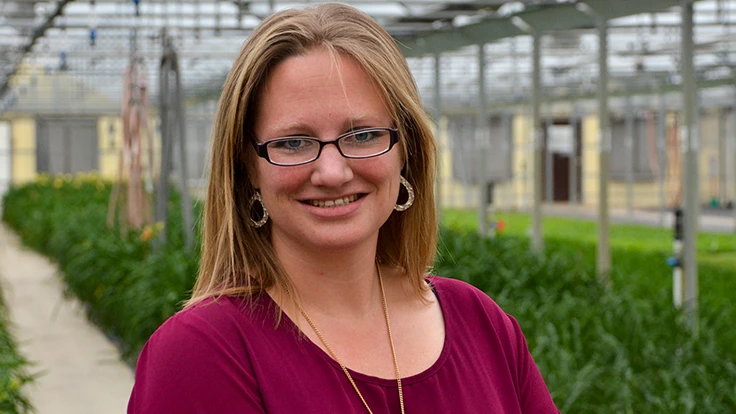
Photo courtesy of Walters Gardens
In the past few days, the Midwest and parts of the Northeast have been hit with extreme cold weather and freezing winds. In Zeeland, Michigan - home to Walters Gardens - the temperature dropped as low as -4 degrees Fahrenheit before accounting for wind chill.
According to trial manager Laura Robles, Walters Gardens has a plan in place to modernize its technology in the next year. Currently, it is working on swapping out old environmental control systems for newer models that allow for remote monitoring and adjusting via a cell phone, computer and other devices.
Still, Robles says Walters does have precautions in place now to prevent production issues.
"By this time next year, we should be able to more actively monitor temperatures from home, from our phones," she says. "When it is this cold, we have people doing checks overnight just to make sure temperatures don't get too low and we do have alarms to alert people if temperatures do drop too low and they need to come in."
GM: How do you prepare the greenhouses for all the snow and cold temperatures?
LR: It's about planning and looking at the weather and keeping an eye on what's coming up. We've seen the forecasts for below zero temperatures - and super below zero temperatures with wind chill - for at least the last week or so, so we've had time prepare and get the plastic up, know to talk with the growers and maintenance and make sure everything feels buttoned up and ready. We must make sure we have people scheduled to come in too.
At every time in the year, growers must be aware of the weather. But with this, it's really being aware and prepared and not trying to do it all last minute.
Greenhouse Management: What is Walters Gardens working on right now to prevent damage or loss as the temperature drops?
Laura Robles: Some of the things that we do are in our cold ranges where we are trying to hold temperatures for fertilization, we are making sure that the heating gets no lower than 36-38 [degrees Fahrenheit] to prevent pipes from freezing. We do have plastic installed over a bunch of our areas when we know it's going to be this cold because it's a more effective way of sealing off those areas. Sometimes we do see stuff that suffers a little bit if we don't cover it with plastic. And in my area and some of the other areas where there [are] high-pressure sodium [HPS] lights, sometimes I'll run them overnight to provide some extra heat over the plants when it's going to be super cold like this. I know in a lot of the different production areas, we have our growers checking them more frequently … [to] make sure that nothing is off or acting funny.
We do have one range this year that we are holding even colder - we're holding it at 28 degrees [degrees Fahrenheit]. In that range, we've had maintenance in there the last two days to make sure [temperatures don’t drop any further].
GM: What is a bigger concern for you: a heavier snow load or freezing temperatures?
LR: It's a little bit of both. For our outdoor field crops, the snow is great. That really helps insulate all our bare root crops out in the field. Our bigger concern is just the weight on the greenhouses. Other than that, it's the cold and the danger of over taxing the system and if our system can't keep up with maintaining the temperatures because of how cold it is outside. We must make sure everything at the end of the ranges is sealed up properly and if we don't, we get some of that really cold air in. That will negatively affect the plants on the end of the greenhouse.
And of course, total system overload is a concern. If everything were to go bad overnight - and you never can know when that's going to happen - and it's a night where it's five degrees below zero, we could potentially lose a whole crop. [Our preparations include] more active monitoring, having more checks in place, people going in at various hours of the night and some other precautions.
GM: When you look at moving past the cold weather and the snow, do you think there are extra steps you have to take to prevent any additional problems due to a temperature change, especially if it's a quick change?
LR: We're about to do that. Right now, it's subzero temperatures and way subzero temps and by Sunday, they are predicting a high of 40 and rain potentially. So it's really just being ready to be on the ball once those temperatures start to go up, re-adjusting temperatures in the greenhouse as needed, getting plastic off the houses so that if we are running houses that are meant to hold temperatures, [because] the plastic needs to be off the vents so they can do their job when it gets warmer. And then it's keeping a close eye on the roofs. If we have a heavy snow load and then it warms up and starts raining and melts, there's more potential for ice on the roof, which could cause more problems, especially with our glass houses.
Latest from Greenhouse Management
- Showing up at your horticulture business as your whole self
- Leading women of Greenhouse Management
- Leading Women of Horticulture: Katie Dubow, Garden Media Group, and Aubry Field, Lizzy Blossom
- USDA fires experts on invasive pests, including Asian citrus psyllid, chilli thrips
- Farwest Show calls for 2025 New Varieties Showcase entries
- Leading Women of Horticulture: Arden Pontasch, North Creek Nurseries
- Leading Women of Horticulture: Emily Showalter, Willoway Nurseries
- Leading Women of Horticulture: Anna Ball, Ball Hort, and Terri McEnaney, Bailey Nurseries





